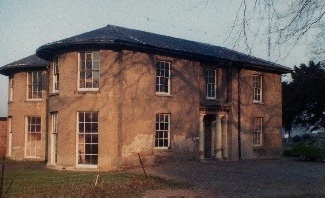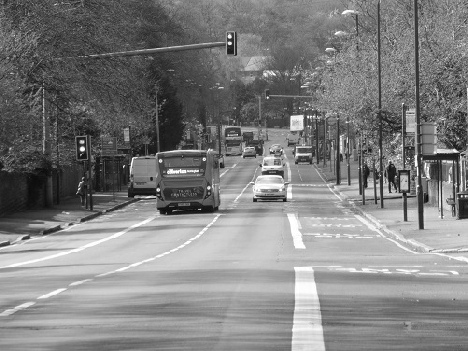Friends of Woodthorpe Grange Park 2023
Return
Sherwood
The namesake that forged its own identity
Nottingham Topic, June 1974
It seems strange that the name of the great forest of Sherwood, over 20 miles long to five to eight miles wide, and embracing a quarter of the whole of Nottinghamshire, should have been applied to an area that had little connection with it.
Modern-day Sherwood, a busy city “suburb”, was given its name in 1792 when the Basford Enclosure Act was passed. But the district was certainly not part of the for, it was, by all accounts, at best a wood and at worst part of a moor, where ling and gorse grass grew. A hundred years later it had developed into an important residential district.
Real movement in Sherwood appears to have started about 1825, when Mr Samuel Cartledge owned Mapperley Place Estate, now Private Road, off Mansfield Road. His property stretched up to and included the top of Mapperley Mount and included a brickyard and its cottages.
On Private Road that was, according to the Poll Book of 1832, nine voters and three in the “Plains” or brickyard cottages, The old Mapperley cricket field was off Private Road, and the members played in top hats.
The history of Sherwood is inextricably entwined with that of its neighbour, Carrington further down the road towards Nottingham. Indeed, Carrington was until comparatively recently considered to be of more importance than Sherwood. But improvements in transport and an increase in development at Sherwood have altered this somewhat.
Carrington was uncultivated before the Act of 1792. Then six acres at the junction of Mansfield Road and Hucknall Road were allocated to Robert Smith Esquire, a member of a great banking house and principal partner in its London Branch.
He was elected MP for Nottingham in 1790, and five times after that in succession. His position as a leading banker led to his peerage in 1796 as Lord Carrington.
He died in 1838 and six acres appear to have been sold to Ichabod Wright who can justifiably be called the founder of Carrington. He divided it into building plots and streets, with a triangular marketplace that was probably also intended as a children’s playground.
Of the homes built in Carrington in the early 1800s, some of the suburban villas on Mansfield Road were probably the earliest.
Into the picture come Samuel and Jonathan Burton, who originally were framework knitters and later point net hands. In 1828 they worked on narrow frames in Broad Marsh, but about 1831 they moved out and built a factory and premises north of the Market Place in Carrington.
In 1837 they dissolved their partnership and Samuel built a factory in Cavendish Vale, now part of Sherwood. The date of the factory chimney is 1838.
Industry was beginning to make an impact on Sherwood and historian Robert Mellors, writing just before the First World War, says “Small houses at the junction of Mansfield and Lloyd Street have their warp machine windows on the second floor up, and Marshall Terrace indicates a transition. The houses opposite the Tram Car Depot were probably built for the use of the factory workpeople.”
Meanwhile, in about 1839, Jonathan Burton was busy building a second, larger factory behind the first on his Carrington site. He lived on the corner of Wesley Street. When steam power was introduced, and the lace makers were relieved of having to turn their machines hour after hour by a hand bar, there was great rejoicing in Carrington, and a lot of beer was consumed.
A few years earlier in 1833, Ichabod Wright had continued with the development of Carrington by giving the land for a school at the corner of King Street, now Selkirk Street.
Services were also held here, until in 1841 Wright provided the site for St. John’s Church for their worship, due to its proximity, Sherwood’s own church of St. Martin’s off Trevose Gardens, was consecrated in 1937. Today (1974) the two churches still have a close association, and publish a joint newsletter.


St. John’s Church, Carrington was opened in 1843 to a design by William Surplice. The chancel was added in 1866 - 1877 by Jackson & Heazell. The north aisle was added in 1922.
St. Martin’s Church, Trevose Garden’s Sherwood designed by Edward Heazell was consecrated in 1937. The church extension, as seen above was, was added in 1966.
It is worth noting that by 1870 the incumbent of St. John’s the Rev. J. G. Wright, had organised the building of a girls’ and infants’ school at the bottom of Hucknall Road.
Lawlessness came briefly to Sherwood in 1842, during the Chartist Riots, when agitators were trying to engineer a general strike to force Parliament to recognise the People’s Charter. An attempt was planned to oust the workmen from Biddle and Birkin’s factory at Mapperley when 2,000 men were assembled. But they were dispersed by the military.
In the 1850s, Cavendish Hill School at Sherwood was kept by the Rev. Thomas Gascoigne in the most westerly house on Edwards Lane. This was a building school for gentlemen’s sons, and some prominent local men were educated there.
There had also been, in the 1830s, a school kept by a Mr. Wilson at No. 700, Mansfield Road, which Sherwood boys’ attended.
There was no post office around this period except at Carrington, and letters were delivered once a day; the receiver had to pay 1d for delivery and 2d for a book or small parcel. There were no lamps on Mansfield Road, or telegraph poles, and no water except from wells.
By 1875 Sherwood consisted mainly of villa residents and superior-class houses. The population was 13,502, and the death rate was 14.9 per 100. Sherwood was finally incorporated into the borough of Nottingham on November 1st 1877.
Just before the First World War, the industries flourishing in the area seem to have been hosiery, lace and embroidery, and the manufacture of towels, cabinets, upholstery, cigar boxes, packing cases, windows, portable furnaces, cycles and paper, plus bleaching, dyeing, dressing and laundry.
According to historian Robert Mellors; “A great industrial and residential population has sprung up, and busy trams ply every few minutes on Mansfield Road, Sherwood Rise and Woodborough Road. The later first ran on May 13th 1902.”
In 1914, Carrington Church School held 198 pupils; Carrington Council Schools 1,192; Haydn Road School 474 and Sherwood School 183.
The growing development of Sherwood was emphasized in 1919 when Nottingham Corporation purchased 127 acres for housing purposes.
One of the oldest places in the area is Woodthorpe House, now used as the Sherwood Community Centre, which also serves other Nottingham suburbs, and sees about 2,000 people pass through its door every week (1974). The centre provides accommodation for educational classes, club meetings and recreational pursuits.

Sherwood Community Centre
In 1832 Woodthorpe Hose was described as the property of Mr Richard Hooton. In 1844, Mr John Fox, a prominent solicitor, lived there. Mr William Cartledge died there in 1859, and afterwards, his widow and daughter continued to occupy. Mr Cartledge’s land was later sold to Sir Charles Seely. At the turn of the century, the house was occupied by Captain Tomasson.
The house ceased to be a private residence, and during the Second World War, it accommodated German and Italian POWs and later as the Regimental Headquarters for the 161 and 172 Mixed Heavy Anti-Aircraft Regiments. After the war, it was purchased by the local authority, and for a while, it was used as a school. But Sherwood Community Association was formed in 1947, and in 1950 it took control of Woodthorpe House. The Association (1974) still runs the community centre with help from the local authority.
At the time Robert Mellors was writing in 1914, a cinema had not yet come to Sherwood. But the cinematograph’s influence was being felt, and Mr. Mellors grim predictions made fascinating reading.
“The Picture House will, of course, be in evidence, but as at the time of writing there has not been one opened, the occasion is fitting one to consider possible effects. Under suitable regulations, the use of the cinematograph may be helpful to religious, moral, and general instruction, and be an instrument for promoting social culture. It may lessen the waste of money spent at public houses. Where however the buildings are so constructed that they are for lengthy periods dark or dimly lighted and contain bad air through imperfect ventilation; owing to flickering and quickly moving films the eyesight of delicate children is as much injured as by the reading of books with small type and bad print, if the pictures of the awful smash, the terrible accident, quickly followed by the ambulance, the hospital treatment, causing undue excitement in young children when they ought to be in bed; and worse still, if Dick Turpin and the burglar and pickpockets methods are exhibited; if the policeman is fooled, and the law evaded by clever immoral conditions not shown, they through the cinematograph much mischief may be done, and it will take much work and time in the School and the Church to overcome it.”
It is doubtful if Mr Mellors could have had any possible idea of how far his dreaded themes would be followed by the filmmakers, even though he shows himself to be a man of considerable perception.
Then and Now


2019: Former Blacksmith’s Workshop, Marshall Street, Sherwood


Circa 1900: Mansfield Road, Carrington
2020: Mansfield Road, Carrington
Circa, Mid 1800’s: Blacksmith’s workshop, Marshall Street, Sherwood
Nottingham Historical Film Unit